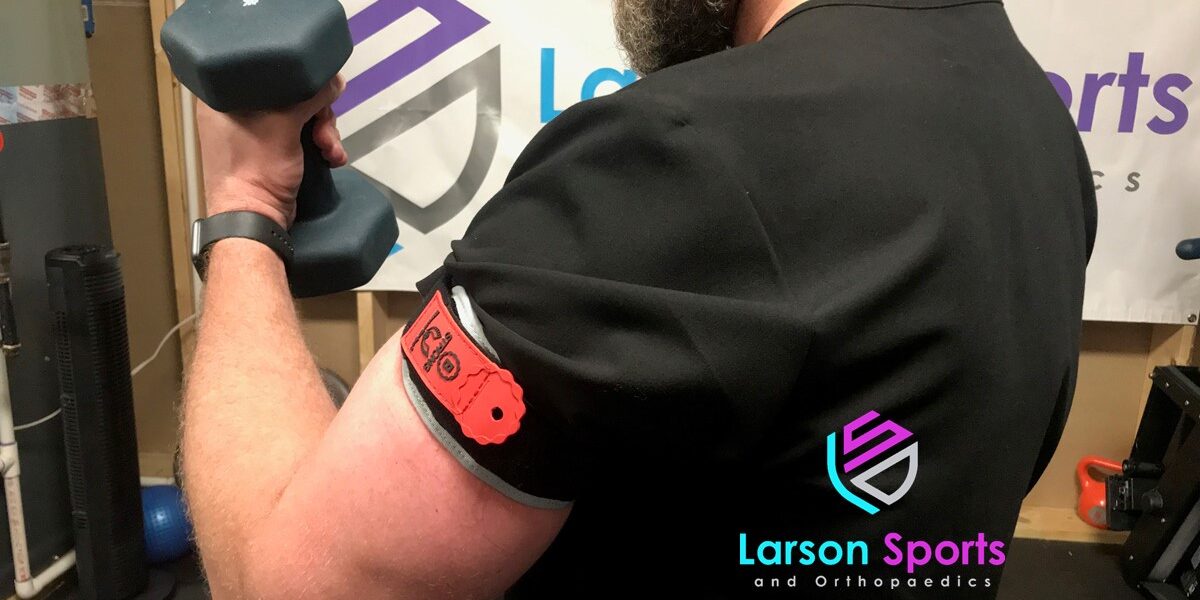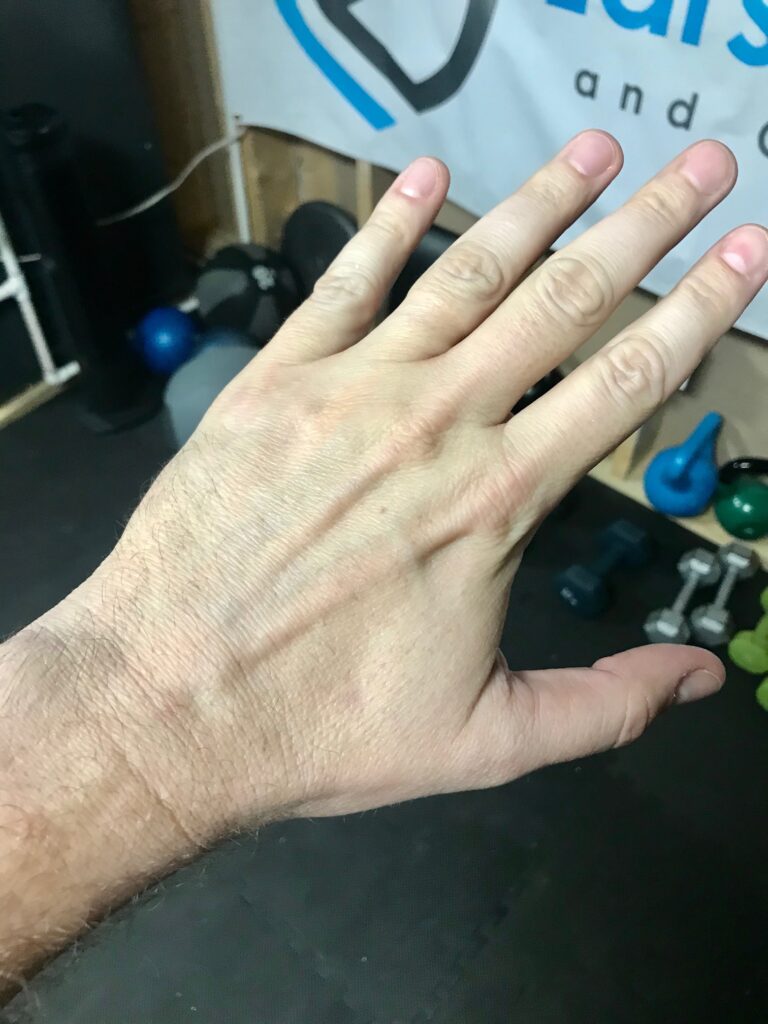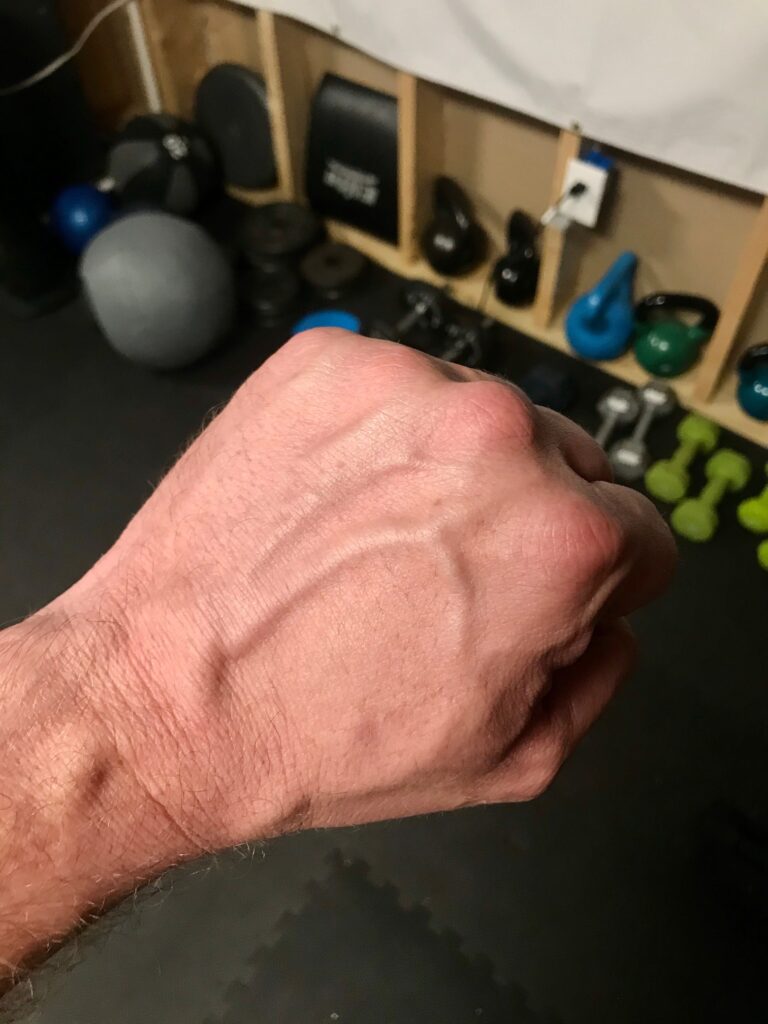You may have seen people at the gym wearing bands around their arms or legs while working out and wondered what they were doing. Well, it is a technique called blood flow restriction training, and it’s becoming much more popular lately. It is a technique that American weight lifters and therapists are starting to use more often. So I decided to check it out, and see if the physical therapists in my office should use it during rehab.
What is blood flow restriction training?
You probably wondering why strapping tourniquets to yourself before exercise ever seemed like it was a good idea!
I’ll be honest I was pretty skeptical at first too. But after spending the last several months looking into it, I’ve changed my mind. I’m actually really impressed by the huge amount of research supporting this technique, and frankly surprised it has taken so long to catch on!
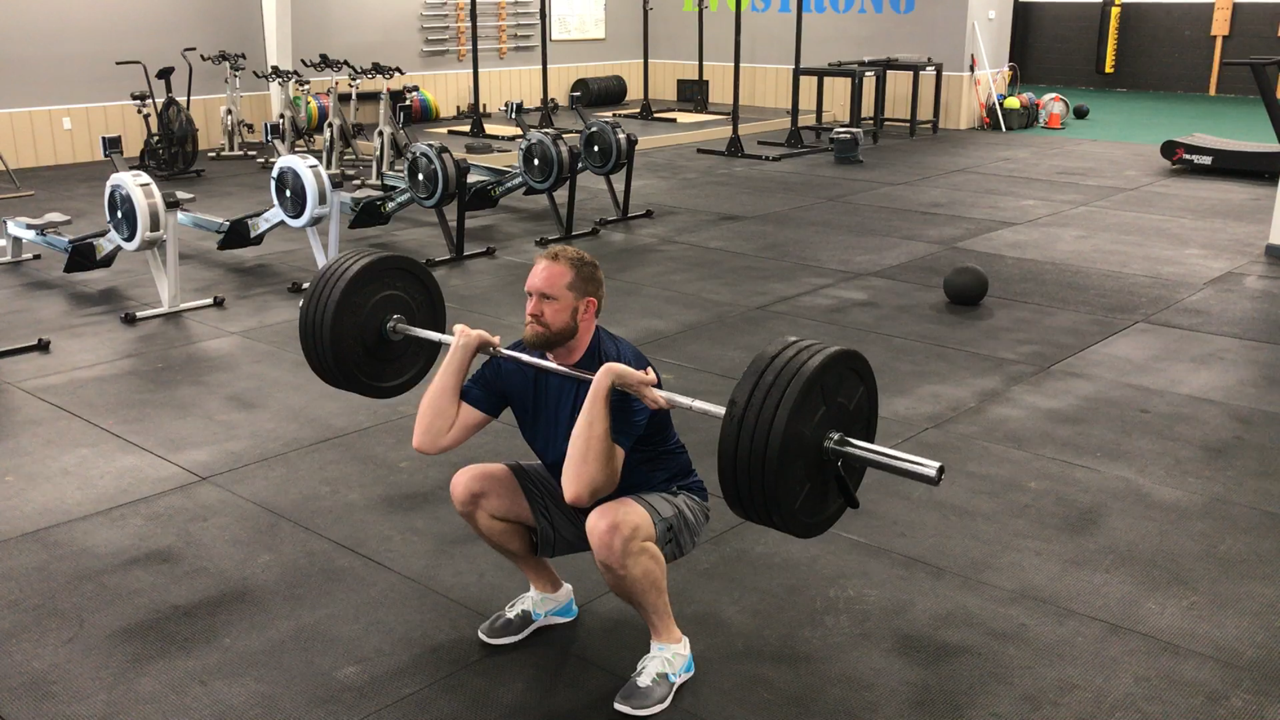
Dr. James Larson is an orthopedic surgeon specializing in sports medicine and arthroscopic surgery. He also holds a CF-L1 certificate and is a Certified BFR Specialist. He supports weight training and high-intensity exercise throughout the lifespan. He started LSO to keep more people moving better, longer.
How Does Blood Flow Restriction Training Work?
Bloodflow Restriction Training is also known as “occlusion training,” “vascular occlusion training,” or “BFR” for short. It induces muscle hypertrophy to improve muscle growth at low resistance levels.
Briefly, low-pressure tourniquets are used to slow the return of blood from the extremities. This causes an accumulation of lactic acid, carbon dioxide, and other waste products to levels normally associated with very heavy workouts.
So it tricks your body into responding as though you’d had a really killer workout even though you are lifting lighter weights than usual. And the response includes increased levels of HGH, IGF-1, VEGF, and other muscle-building hormones.
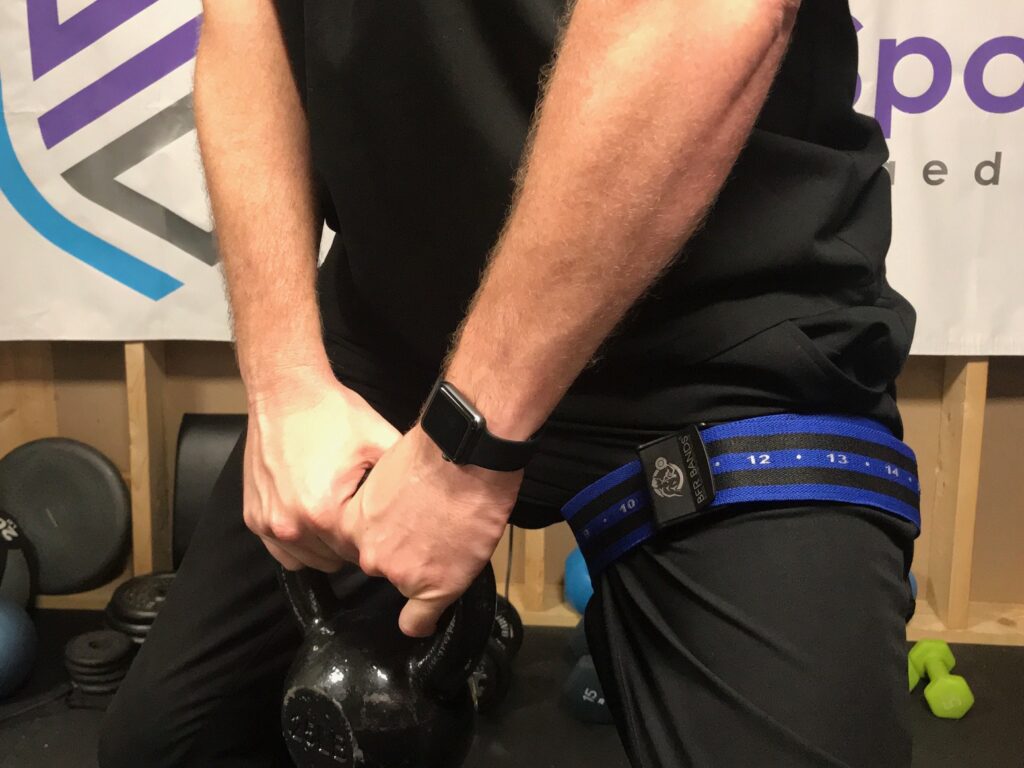
Who Can Benefit From BFR Training?
While blood flow restriction training was originally used for physical therapy and rehabilitation, it is now frequently used by bodybuilders and other people trying to maximize muscle gains with less stress on their joints, tendons, and ligaments.
After trying it myself, I can see that lots of different people could benefit from it. Maybe you have spinal disease, arthritis, tendinitis, or other problems that make heavy lifting painful. With BFR you can still keep building those muscles without as much stress on your back, hips, knees, and other joints.
You can see the benefits of BFR if you are a Weekend Warrior or when recovering from an injury. It’s great for Baby Boomers that want to stay strong or professional athletes looking to maximize performance. Seriously competitive amateur athletes can also benefit from blood flow restriction training. The only difference is in how you tailor it to meet your goals.
BFR Training: The Equipment
Occlusion training can be done with either inflatable or elastic bands, also called cuffs. But these aren’t just blood pressure cuffs. BFR bands are narrow to help block venous blood flowing out of muscles while still allowing arteries to deliver blood to them. And they often have extra safety features built in.
This post contains affiliate links. If you want to purchase any of these items, please use the link in the article. Amazon doesn’t let us post the prices, so you’ve got to click the link to check them, sorry. We do get a small percentage of your purchase without costing you any more. The products may be available for purchase elsewhere but we appreciate it when you use our links, it helps to keep the servers running. Thanks for your support!
Top Recommended Blood Flow Restriction Cuffs
If you are looking for a long term investment in fitness equipment, you’ll want to go with one of the better inflatable brands like B STRONG. These are a great option for personal trainers and therapists who want to offer BFR to clients. In fact, B STRONG is the brand we use in my physical therapy office.
They’re also a great option if you are looking for an alternative to a full weight stack. Let’s face it, heavy iron is both expensive and hard to find during the pandemic. A high-quality set of BFR bands can help keep your gains if you are forced to work out at home with whatever weights you can find.
My Recommendations
I’ve tried all of these brands below and summarized my opinions so you can see which one is right for you.
 | 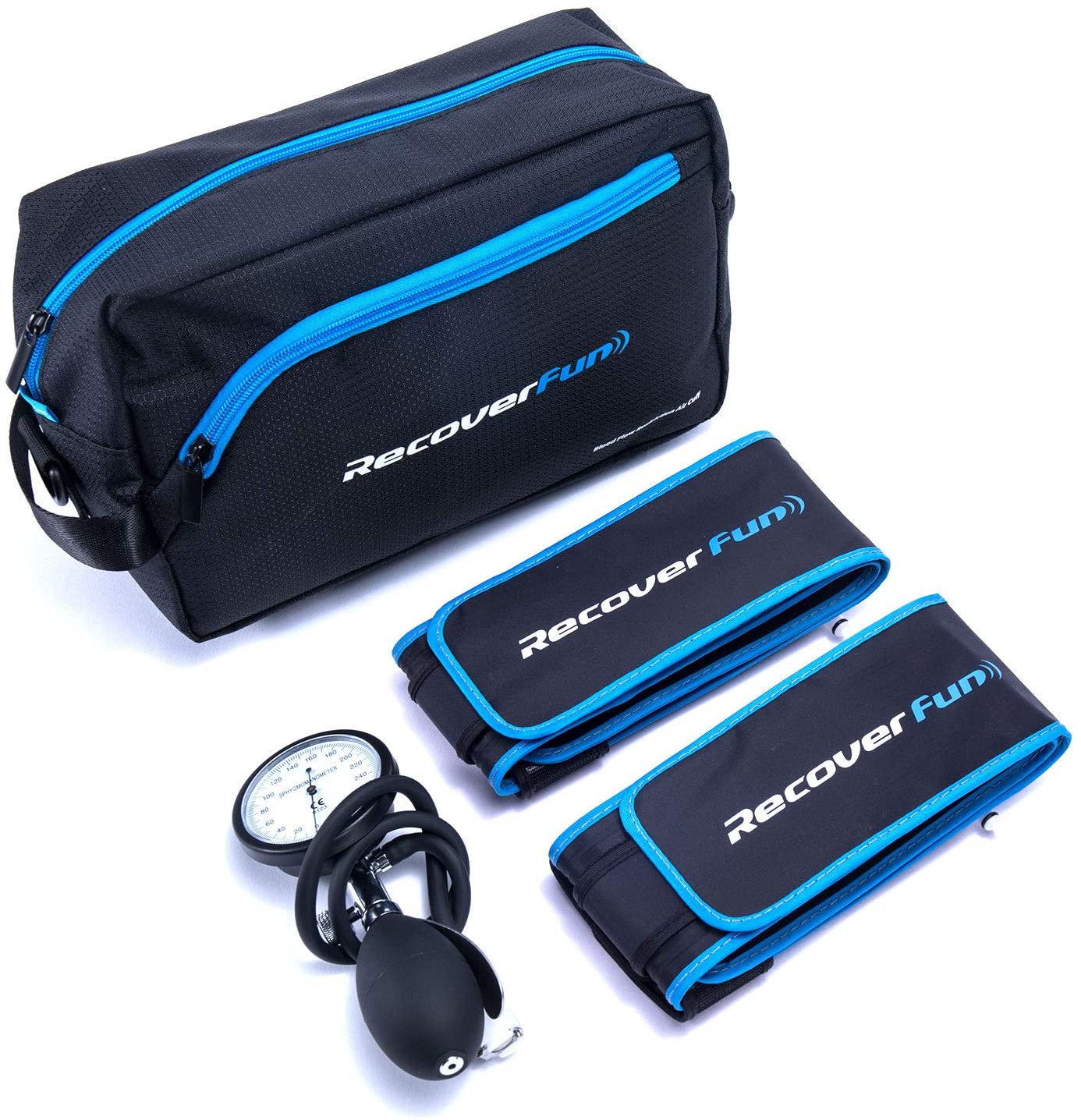 | 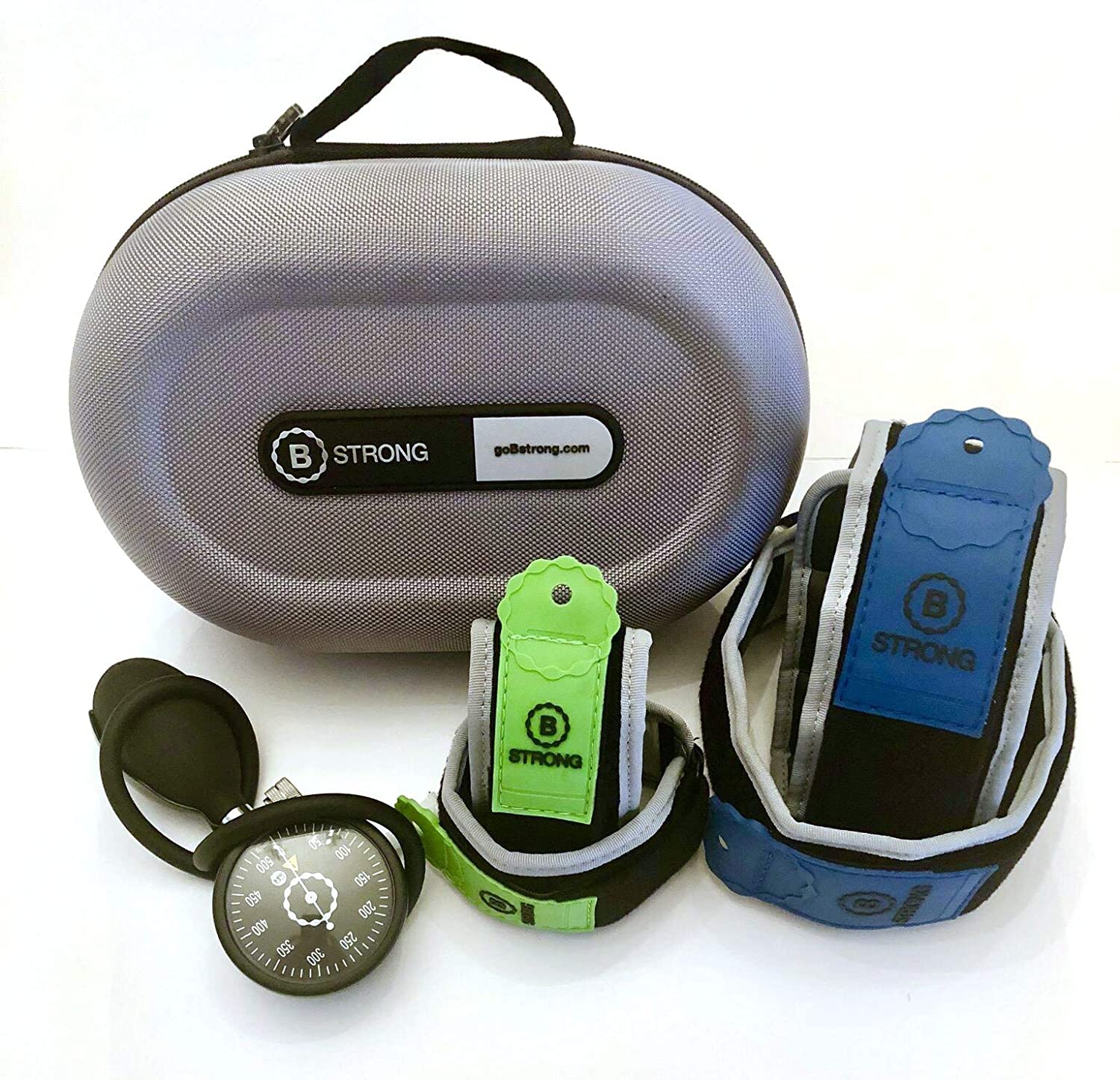 | |
| BRAND | BFR Bands | RecoverFun | B STRONG |
| STYLE | Elastic Strap | Inflatable | Inflatable |
| PROS | Simple and no-nonsense. Hard to over-tighten. Easy to use buckles. Includes narrow bands for arms and wider bands for legs. Elastic loop keeps slack in place. | Affordable and effective. Large enough for arms or legs. Easy to reproduce the pressure each time. Secure Velcro closure. | Best Design and construction quality. Almost impossible to over-tighten. Most comfortable BFR bands by far. None of the downsides of other brands. Designed by an MD. |
| CONS | Variable pressure. Elastic may stretch over time. Buckles may pinch. Can flip open during exercise and release the pressure. | Can easily over tighten. Too wide and long for easy use on arms. Double sided Velcro sticks to clothing. | The main downside is cost. But you get what you pay for! And be careful when ordering them, since the photos are the same but the band sizes are different. |
| WHO’S IT FOR | People who want to try BFR before investing much money. Those who do it intermittenly or just want a little training boost. | Fitness enthusiasts and amateur athletes who want more easily reproducible band pressure. | Professional trainers and therapists. Those looking to replace a full weight stack. Dedicated aspiring competitive and professional athletes. |
| COST | $ CHECK LATEST PRICE | $$ CHECK LATEST PRICE | $$$ CHECK LATEST PRICE |
Cuff Placement
NEVER put the bands near you elbows, knees, wrists, or ankles. The arteries and nerves are close to the skin here are high pressures can cause real damage.
Blood Flow Restriction bands should ONLY be placed at the TOP of your arms or legs. On the arms they should go right below your shoulders. And on your legs they should go at the top of your thigh – just below your butt.
How Tight Should BFR Bands Be?
The usual recommendation for BFR band compression is to aim for a subjective pressure between 4 and 7 on a 0-10 scale. Above that level, you risk cutting of the arterial blood supply into the muscles. But below a 4 doesn’t really produce enough compression to be effective.
Some elastic BFR bands have numbers on the sides. Those numbers are just there so you can remember the setting that works best for you. They aren’t related to the pressure scale. You should be focused on how tight the bands feel to you, no matter what the reading on the bands are. You want to stay between 4 and 7 on a scale where a 10 is as tight as you can possibly tolerate.
Is it better to be a little too tight or a little too loose?
Being a little too loose is definitely better. Studies have shown the same level of gains when using cuffs with pressure as low as a 4/10. And remember, the tighter you make them, the higher your risk of doing real damage. So take it easy, HE-MAN; you want to slow the venous blood return, not twist your leg off.
Signs that the bands are too tight:
- Collapsed, flat veins in hands and feet
- Pale, white fingers or toes
- Pounding pulse at the bands
- No pulse at the wrist or ankle
- Numbness
Signs of properly tightened BFR bands:
- Slightly redder, darker color to extremities
- Increased visibility and distension of veins in hands and feet
- Tight feeling in muscles while working
- Pulses still detectable at wrist and ankle
How Many Reps/Sets Should You Do?
The lifting routine for Occlusion Training is quite different from what you are probably used to. This is high volume, low resistance training. You want to use weight that is about 25%-35% of your one-rep-max and do three sets of 20-30 lifts for each exercise.
Generally, you do between 3-5 exercises during a session. And work on either the arms or legs during a session, but not both. Remember, these are high volume sets close together; 30 second rests between sets and 1-2 minute rests between exercises.
Which Exercises Should I Do?
Remember you want to go light with the resistance on these exercises. You want to use a weight that’s about 25-35% of what your maximum single lift would be. So if you can curl a 40 lb dumbbell once, then use between 10 and 15-pound dumbbells for the same exercise with BFR bands.
Typically you will do three sets thirty reps of each exercise, with a thirty-second rest between sets. Here are some examples of different recommended exercises.
| Upper Body | Lower Body | Full Body |
| Curls Triceps Kickback Skull Crusher Overhead Press Upright Row Bench Press Push-Ups | Split Squat Terminal Knee Extension Hamstring curls Calf Raises Ball Slam Glute Bridges Reverse Lunges | Jumping Jacks Goblet Squat Thruster Mountain Climbers Bird Dog Kettlebell Swings Endurance |
The Full Body exercises can be done on a separate workout day, or as a finishing burner to your other exercises. You can use the bands on your upper or lower body during these complex movements. You can put bands on all four extremities when using the B STRONG bands since they are designed for it.
Just be careful using four bands if you are prone to lightheadedness, dizzy spells, POTS Syndrome, or low blood pressure.
How Frequently Should You Do BFR?
Everyone’s fitness goals are different. So BFR training should be integrated into your workout routine in different ways.
- 2-3 Times a week if you are just trying to stay in shape. Mix it in with your cardio. That can be on the same day, or alternating. And remember to work on your core strength too.
- 3-4 times a week if you are recovering from an injury or surgery. You’ll be doing very light resistance. You won’t need as much recovery time in this case. And your goal is just to maintain your muscle bulk and prevent atrophy.
- Competitive athletes will want to integrate it into their exercise cycles. The US ski team uses BFR bands while on the ski simulator. And you can use it while deloading to maintain muscle while letting it heal.
Remember that recovery is important after vigorous exercise, and BFR is no exception. You need to give your body the time to grow the muscles in response to your workouts. And don’t forget your flexibility and cardio training. Muscles aren’t everything!
But what about my chest and/or butt muscles?
Will frequent BFR lead to asymmetry? Will it develop your arms and legs more than the chest, back, and butt muscles? Actually BFR seems to help build up your chest and glutes even though they are above the bands.
For example, doing low-load bench press with BFR cuffs on the arms has been shown to increase pectoralis growth, not just the triceps. In one study they saw an increase of 15% muscle thickness in the pecs when using BFR, compared to only 4% without BFR. We don’t know exactly why but hypothesize that it is due to the systemic hormones released during occlusion training.

Is Blood Flow Restriction Training Dangerous?
The pressures typically used during BFR training are very safe. Most of the time, you are using pressures below 100 mmHg during BFR.
In contrast, when we use tourniquets during orthopedic surgery they are inflated high enough to completely block all blood flow. That’s usually 250-300 mmHg; and we keep them inflated for up to two hours at a time. I’m not suggesting you do that, merely showing you that low-pressure BFR isn’t too dangerous.
Remember that you should usually consult your physician before beginning any exercise routine if you have medical conditions. But occlusion training is not dangerous for healthy people when performed correctly.
If you are healthy enough to engage in high-intensity exercise already, BFR training should be fine. If you are new to it, you should seek a therapist or trainer who can show you how to do it safely.
Does BFR cause damage to the veins?
There is some concern that squeezing veins regularly could lead to damage in the long term. But an initial study actually indicates the opposite. It may improve venous blood flow over time. Of course we can’t really make that assessment from a single small study. But we should investigate it further.
Of course, this assumes you are doing it correctly. Making the bands too tight could definitely damage tissue. But light, short term venous occlusion shouldn’t cause any damage.
It is also important to understand that light venous compression is already a medically accepted method of improving venous blood flow and preventing clots. After hip or knee replacements, we use sequential compression devices (SCD’s) to prevent blood clots. And they squeeze with about the same pressure as BFR bands.
Who should not be using blood flow restriction training?
While this is not a comprehensive list, and it may change over time, some people who should be cautious about using BFR include those with:
- Sick Cell Disease
- Recent Vascular Surgery
- Chronic Venous Disease
- Blood Thinners
- Reynaud’s Phenomenon
- Bleeding Disorders
- Peripheral Vascular Disease
- POTS Syndrome
There are certainly other conditions which may preclude the use of occlusion training. And this list may change over time. It may eventually be shown that BFR could possibly help people with venous stasis disease, but we don’t know the answer to that yet. So I always recommend checking with your physician before trying it.
How did BFR Training Begin?
Congratulations! If you’ve made it this far you are really dedicated to learning about BFR training. So I’ll give you a little bonus info about how it got started.
BFR was invented by a Japanese therapist, Yoshiaki Sato, around 1994. After sitting in a traditional kneeling position for a long time at a funeral, Sato realized that his calves felt just as if he’d done a vigorous workout.
From there he wondered if sitting on his calves had slowed blood return, trapping CO2, lactic acid, and other waste products. This, he thought might trick the muscles into growing because they felt like they had done a heavy bout of exercise.
Further research proved his hypothesis, and he started KAATSU training – the origin of BFR. He tried it out on himself as one of the first test subjects. After breaking his ankle, he decided to use BFR on the injured leg while he was in a cast for 8 weeks. He found that he’d prevented almost all of the atrophy that usually comes from being in a cast for that long. And the rest is history.

Looking to recover faster? Check out our guide to choosing the best turmeric supplements for your needs.
This does not constitute specific medical advice and does not indicate a physician-patient relationship between Dr. Larson and readers of this website. Please consult your own physician regarding any of these recommendations before starting them.
References
Libardi, 2015. Effects of exercise intensity and occlusion pressure after 12 weeks of resistance training with blood-flow restriction
Clark, 2011. Relative safety of 4 weeks of blood flow-restricted resistance exercise in young, healthy adults
Martin-Hernandez, 2013. Muscular adaptations after two different volumes of blood flow-restricted training.

